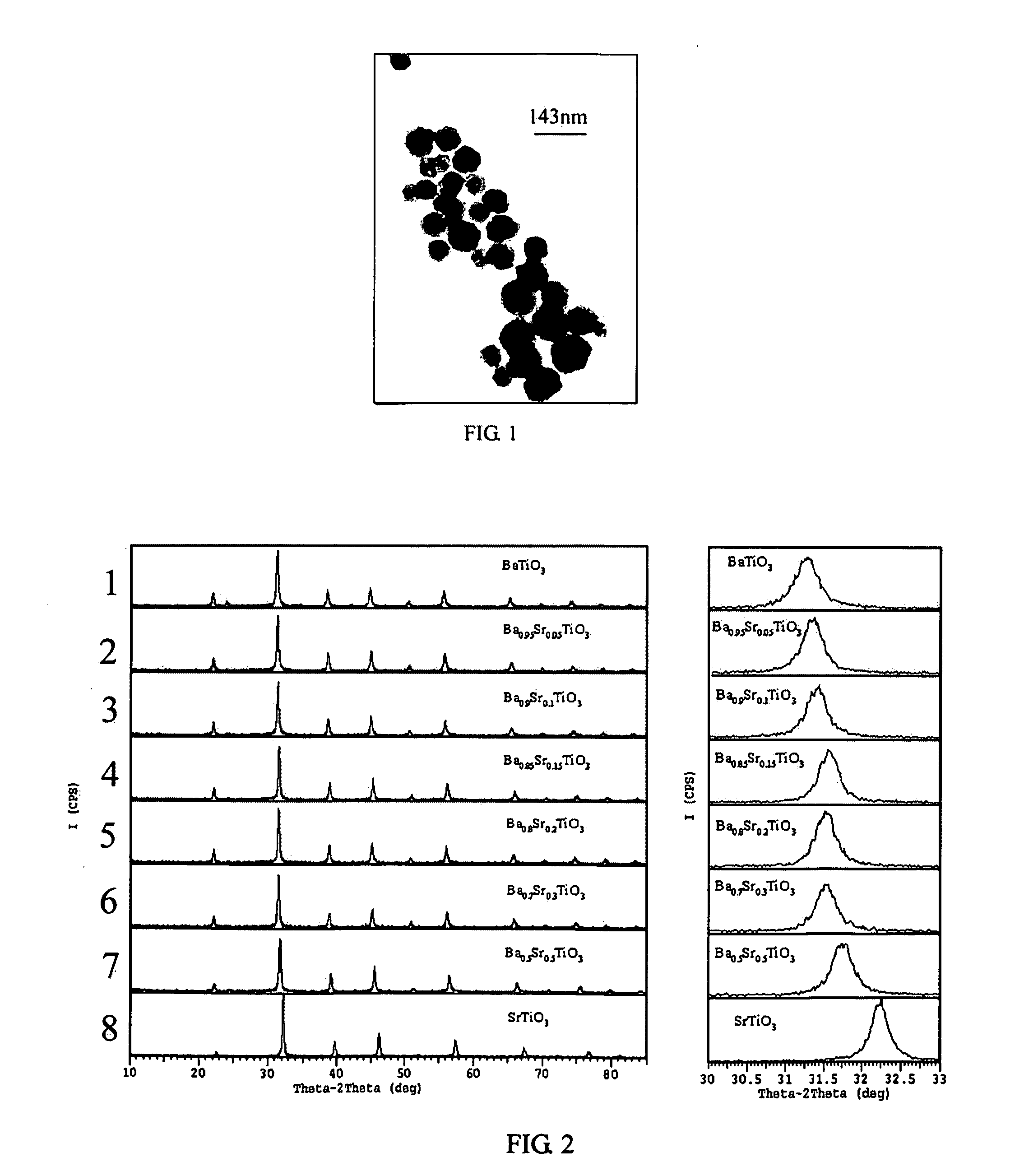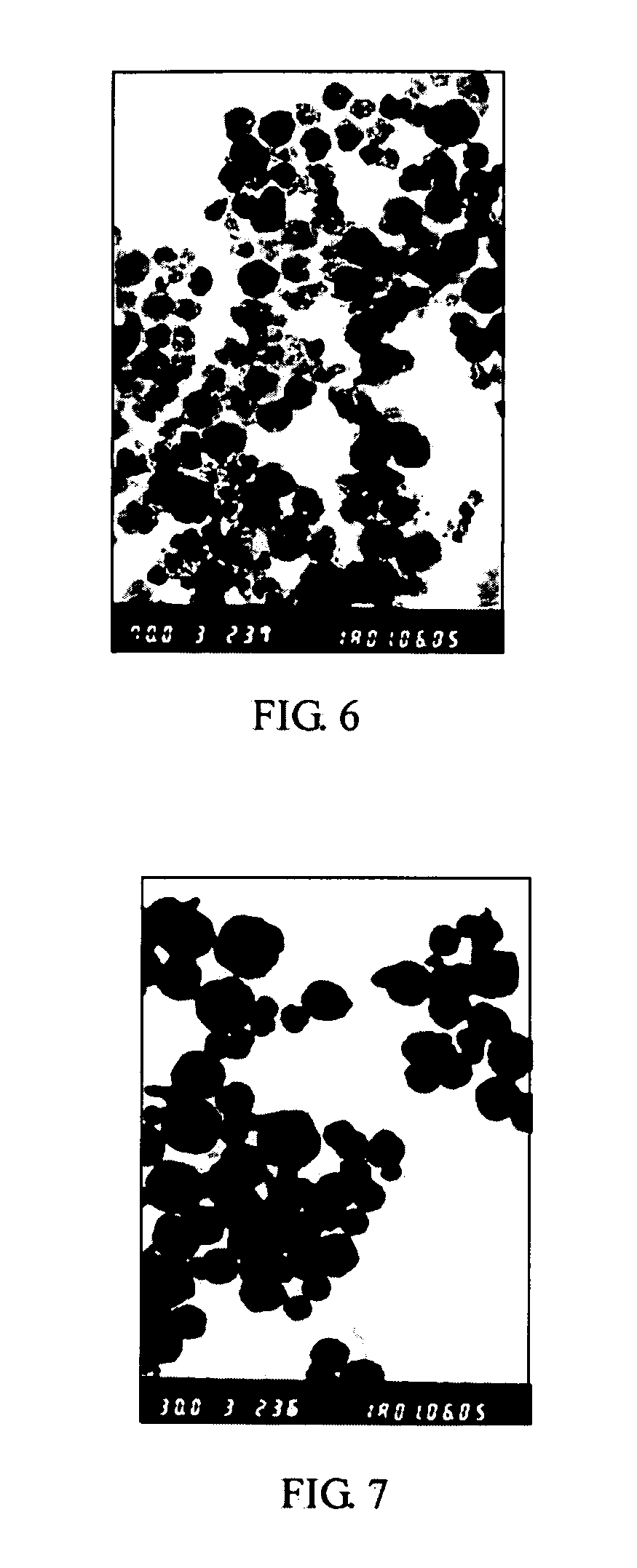Process for preparing perovskite-type crystalline compound powders
- Summary
- Abstract
- Description
- Claims
- Application Information
AI Technical Summary
Benefits of technology
Problems solved by technology
Method used
Image
Examples
example 1
Preparation of Barium Strontium Titanate by the High-Gravity Technology
[0058] 4.5 mol / L of NaOH solution was prepared, wherein NaOH was analytical pure. The NaOH solution was added into the stainless NaOH storage tank 1 (as shown in FIG. 9). The preparation of a combined solution containing (BaCl2+SrCl2) and TiCl4 comprised the following steps: preparing a SrCl2 solution with a concentration of 2.0 mol / L, a BaCl2 solution with a concentration of 2.0 mol / L and a TiCl4 solution with a concentration of 2.0 mol / L, respectively; preparing a combined solution containing [BaCl2]+[SrCl2]+[TiCl4] with a total concentration of 1 mol / L by adding deionized water, the molar ratio of [SrCl2] / (BaCl2+SrCl2) being kept at 0.15, and the molar ratio of ([BaCl2]+[SrCl2]) / [TiCl4] being kept at 1.05. The combined solution containing BaCl2, SrCl2 and TiCl4 thus prepared was added into the storage tank 6.
[0059] After the high-gravity reactor was started up, the combined solution containing BaCl2, SrCl2 ...
example 2
Preparation of Barium Strontium Titanate Doped with Different Amount of Strontium by the High-Gravity Technology
[0063] The experimental conditions were the same as example 1 except the following changes.
[0064] The experiment was repeated using the same procedure as described in Example 1 except that the molar ratio of [SrCl2] / ([BaCl2]+[SrCl2]) was 0.05, 0.1, 0.20, 0.30, and 0.50, respectively. The obtained powers had a particle size of less than 100 nm. FIG. 3 and 4 showed the TEM images in the case that the molar ratio of [SrCl2] / ([BaCl2]+[SrCl2]) was 0.2 and 0.5 respectively. FIG. 2 illustrated XRD graphs of the powders doped with different amounts of Sr, as rows 2, 3, 5, 6 and 7, respectively.
example 3
[0065] The example illustrated the preparation of barium strontium titanate powders using different reactants.
[0066] 4.5 mol / L of NaOH solution was prepared, wherein NaOH was analytical pure. 1 mol / L of Sr(OH)2 solution and 1 mol / L of Ba(OH)2 solution were prepared respectively. The NaOH solution, the Sr(OH)2 solution and the Ba(OH)2 solution as described above were mixed to form a combined solution having a volume of 10 L. The concentration of [OH—] in the combined solution was 6.0 mol / L, and the total concentration of [Ba2+]+[Sr2+] was 0.5 mol / L, while the molar ratio of [Sr2+] / ([Ba2+]+[Sr2+]) was kept at 0.15. The combined solution containing NaOH, Sr(OH)2, and Ba(OH)2 prepared as described above was added into the stainless NaOH storage tank 1 (as shown in FIG. 9). 10 L of TiCl4 solution with a concentration of 0.48 mol / L was prepared, and then charged into the storage tank 6.
[0067] After the high-gravity reactor was started up, the TiCl4 solution with a concentration of 0.48 ...
PUM
| Property | Measurement | Unit |
|---|---|---|
| Temperature | aaaaa | aaaaa |
| Temperature | aaaaa | aaaaa |
| Size | aaaaa | aaaaa |
Abstract
Description
Claims
Application Information
 Login to View More
Login to View More - R&D
- Intellectual Property
- Life Sciences
- Materials
- Tech Scout
- Unparalleled Data Quality
- Higher Quality Content
- 60% Fewer Hallucinations
Browse by: Latest US Patents, China's latest patents, Technical Efficacy Thesaurus, Application Domain, Technology Topic, Popular Technical Reports.
© 2025 PatSnap. All rights reserved.Legal|Privacy policy|Modern Slavery Act Transparency Statement|Sitemap|About US| Contact US: help@patsnap.com



